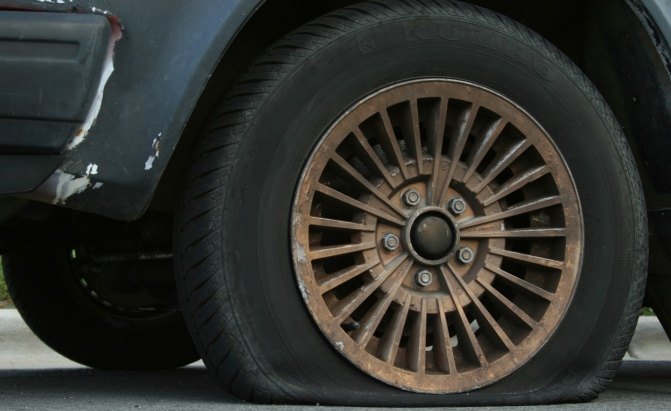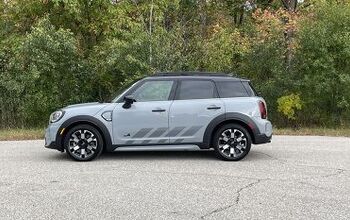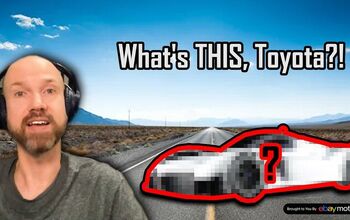Here's Why You Really Shouldn't Drive on a Flat Tire

Updated September 2019
Getting a flat tire on the road can be a scary experience, but what you do in the moments after a tire loses pressure is very important. Here’s why you really shouldn’t drive on a flat tire.
When a tire loses a significant amount of air pressure, it’s what is referred to as flat. This can occur for many different reasons, such as a defect, improper air pressure, a puncture, or over use.
Although it is rare, some tires do have built-in defects that may be visible as bumps or bulges on the sidewall of the tire. If you ever see these types of abnormalities, do not drive on the tire and have a certified tire mechanic inspect it right away. Another sign that your tire may soon fail are cracks in the surface. If you spot cracks in the surface of your tire, it’s very likely the tire is too old and should not be driven on.
SEE ALSO: How Far Can You Drive on a Spare Tire?
A tire that is at the end of its life cycle can also show signs it may rupture if it’s not replaced. Any tire under 2/32nds of tread depth should be replaced as soon as possible and any tire with the steel belts showing through the tread should not be driven at all. It’s important to always check your air pressure as well to ensure it’s at the correct level. Driving on under-inflated tires causes increased wear, damage and heat that can lead to a tire prematurely failing. Remember that fluctuations in temperature can also affect your tire pressures.
Top 15 Best Portable Tire Inflators and Air Compressors
A puncture is much harder to prevent and can occur on a seemingly clear stretch of roadway. Regardless of what causes a tire to go flat, when it does happen, it’s imperative to minimize the amount of time spent driving on it.
Pull Over Immediately
We’ve all seen it before; some of you may have even done it. A vehicle has had a tire go flat and the driver is slowly driving on the shoulder on of the road. Instead of waiting on a tow truck or taking the time to install the spare tire, drivers sometimes try to ‘limp’ their cars to a nearby service center. This is not the right response to a flat tire. As Goodyear states:
“Maintaining proper air pressure is an important factor in tire safety and performance. If a driver experiences a flat tire or loss of air pressure, they should slow the vehicle gradually and carefully pull off to the side of the road as soon as possible. Driving on a flat tire can cause internal structural damage to the tire, may lead to wheel and vehicle damage and may result in poor vehicle handling and control — which could lead to an accident, injury or death.”
SEE ALSO: Craftsman Torque Wrench Review
Cooper Tire reiterates this point, pointing out that “Flat or underinflated tires can do harm very quickly. According to Cooper, tires driven even a short distance while under-inflated may be damaged beyond repair. Running a tire under inflated is like running the vehicle’s engine without enough oil or coolant. It may seem to work fine for a time, but serious permanent damage has occurred. Adding oil or coolant won’t repair engine damage, and adding inflation pressure won’t fix tire damage.”
A Flat Doesn’t Always Mean a New Tire
This all may sound a bit extreme, but it’s true. Let’s start with the reasons why driving on a flat tire is not a good idea for the tire itself. A lot of flats occur because the tire gets punctured. Most things that create the puncture are small, like nails and screws. As John Carpenter, field service manager for Toyo Tire Canada states, “Industry guidelines allow repair of punctures of up to 1/4″ in diameter in a tire’s tread area.”
SEE ALSO: Top 12 Best Jack Stands
This means a simple tire puncture can be fixed with a tire plug. But, if a tire is driven on after the initial deflation occurs, more damage can occur to the tire, as the sidewalls can rupture and the initial puncture can expand. As Carpenter says, “Repair of any punctures in the shoulder and sidewall areas are not permitted. Repair of larger tread punctures, long straight cuts and irregular gashes are not permitted.”
Not Just the Tire is at Risk
And if a tire degrades enough when being driven while flat, it can start to break apart and cause damage to several important components on a car. Brake lines, rotors, calipers, suspension components, wheels and fenders can get serious damage from a flat tire that begins to flail around in the tire well. What starts off as a simple $30 tire patch can end up costing thousands of dollars if a flat tire is driven on for an extended period of time.
ALSO SEE: The Pros and Cons of Run Flat Tires and the Best Run Flat Tires You Can Buy
But more of a concern is occupant safety. If any of the braking or suspension components do get damaged, the car may behave unexpectedly, that could result in a crashing injury or, in a worst case scenario, death.
What to Do When You Do Have a Flat?
If a flat does occur, it best not to panic and DO NOT drive on it. Safely maneuver to the side of the road and either installed the spare tire (if one is supplied) or get a tow to a local tire shop. Although this means a minor inconvenience and/or cost in the short term, it’s worth it in the long run. You can do massive damage to your vehicle if you continue to drive and more importantly, you will be putting you and other motorists at risk.
SEE ALSO: Top 10 Best Torque Wrenches
How to Avoid a Flat
The best way to deal with a flat tire is to never have one in the first place. Cooper Tire has tips and advice regarding the most important factors when it comes to tire care:
- Proper tire size, type and load capacity (or load range)
- Proper inflation pressure
- Proper vehicle loading
- Regular tire rotation
- Regular inspection
- Proper tire repair
- Vehicle condition, alignment and maintenance
- Good driving habits
Be sure to inspect your tires frequently – especially if you commute far distances often. Tires can become damaged quite easily while out on the road. Potholes and other rough bits of road and asphalt can cause your tire to bubble or cause the sidewall to tear. Extreme heat or extreme cold temperatures can also cause the tire pressures to fluctuate, so you will want to keep an eye on your tire pressures year-round as well.
In short, you should always keep a close eye on your tire tread wear and tire condition, as this is critical to your safety when out on the road.
When you Can’t Plug a Tire
As mentioned above, plugging a punctured tire is often a simple and affordable alternative to buying an entirely new tire. But it’s not always possible.
As a general rule, if you have a nail or other object stuck in your tire, it can be patched if it’s closer to the center of the tire (either in the tread or in the void between the tread). If the nail or other object is near the outside of the tire, in the “shoulder” tread block or in the actual sidewall of the tire, it cannot be plugged.
Become an AutoGuide insider. Get the latest from the automotive world first by subscribing to our newsletter here.

A 20+ year industry veteran, Mike rejoins the AutoGuide team as the Managing Editor. He started his career at a young age working at dealerships, car rentals, and used car advertisers. He then found his true passion, automotive writing. After contributing to multiple websites for several years, he spent the next six years working at the head office of an automotive OEM, before returning back to the field he loves. He is a member of the Automobile Journalists Association of Canada (AJAC), and Midwest Automotive Media Association (MAMA). He's the recipient of a feature writing of the year award and multiple video of the year awards.
More by Mike Schlee





































Comments
Join the conversation
I did 40 meters away from a busy road on a flat, with an alloy. doooodgy :) tyre was worn though.
My car was stolen on Friday and then Saturday morning got in a high-speed chase. The cops laid down a spike strop and my car got two flat tires and I guess the girl driving it kept driving on rims for an hour. I now have to pay $700 deductible and they say my car will be fixed but I'm hoping they just call it a total loss and pay me out because I don't want the car back. What other damages can occur from driving on the rims or just the erratic driving itself ?.